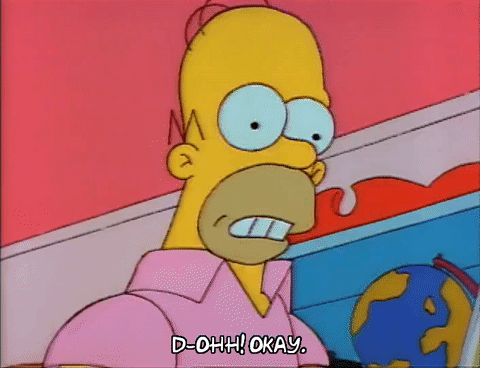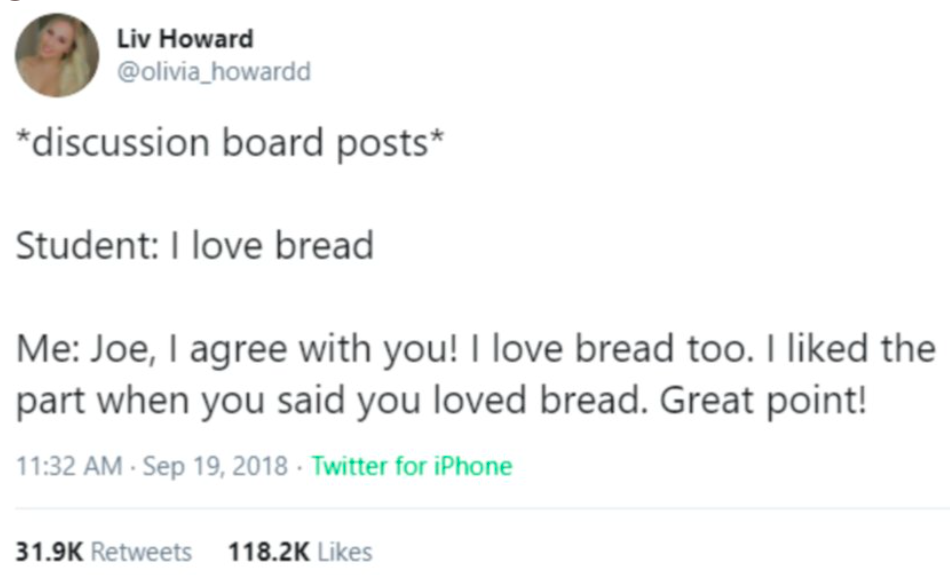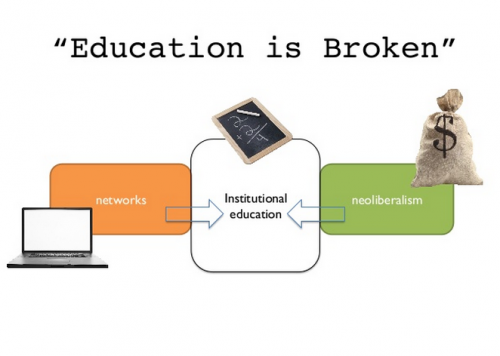‘The future is already here, it’s just not very evenly distributed‘
– William Gibson on NPR, August 1993
As a card-carrying Gen X human and longtime online educator, I’ve been seeing & hearing the quote above pretty much my entire career. I used to think it was about…well…the internet.
I’ve changed my mind. As I try to redesign my courses for online delivery and advise fellow educators being asked to prepare for online and HyFlex and everything else in the midst of the mad YMMV* of this whole ‘Year of the Pandemic’ misadventure, it occurs to me Gibson may have been a time-travelling Nostradamus, sent back in time from higher ed 2020. Because never have I seen ‘the future’ move so fast. And never have I seen such uneven fault lines laid visible in the process.
(Side meander: I read this Encyclopedia Brown book as a kid where the Boy Detective figures out that a war relic is a fake because its engraving is marked “The First Battle of X.” I distinctly remember Boy Detective smugly pointing out that nobody knew there was gonna be a Second Battle at the time of the first. ie, this ONLY goes down as ‘the Year of the Pandemic’ if we can be one and done by the time we see 2020 out. I have deep doubts about us, people, but…rolling with it.)
***
In the spirit of full disclosure, since you may not have realized you were being lured here by a title best described as ‘flippant and ill-considered,’ let me note that the idea of three easy steps to online re-design is a sardonic fiction. Redesign is a complex process and an ever-evolving one, full stop.
This post is effectively a really long “I don’t know who needs to hear this, but.” Key takeaways? It doesn’t get easy. And that doesn’t mean you’re doing it wrong.

Redesigning for online is a confronting process. It forces you to pare down both your course content AND your course communications to the bits that matter most, then demands that you consider how these things work together.
This is NOT a bad thing. This year of pandemic and protests makes visible the huge variabilities and inequities baked into so many of the systems we participate in. Removing the four walls of the classroom doesn’t magically create inequities in education…they’re present even when everyone sits together in the same space for the same amount of time. Brains and bodies vary: so do the experiences and expectations and assumptions teachers and learners bring with them about each others’ brains and bodies. We all live different realities.
Bitter truth: for the first month of the pandemic I had a full fight/flight recoil from any reflective process. What I lost in the capacity to think in full sentences, though, I gained in the ability to commandeer a fridge and pantry. I am not the cook in our family, but overnight, I became like someone who survived the Great Depression: hark! A stalk of celery and a tin of tomatoes! I can make a gourmet dinner AND make sure there are leftovers that get promptly eaten the following day. We used the hell outta our resources, for months.
This is what some of us do in uncertainty: focus down to immediate needs and capacity. The amygdala rules.
My partner, on the other hand, worked ten hour days, wrote half an Online Teaching textbook, and created an entire site of video resources and interviews about digital pedagogies and Online Learning in a Hurry. Jackal. ;) Even from the same house, we had totally different responses to the stress of the adaptation.
Come September, we won’t know what these last months have been in our students’ lives. We won’t know what their present is.
But we do need to know that going online forces a more drastic contention with the variable social and societal and financial and responsibility contexts in which our brains and bodies are embedded: online forces us to intentionally identify ALL the elements of our course communications and consider how those different contexts might shape how learners receive and perceive the constructs of our classes.
To circle back to Gibson, the internet has always distributed both the future and the present highly unevenly.
***
On the redesign front, I need to be clear: I have it as good as anybody could. Online is my field. I started on my online learning journey back in 1998. I have a tenure-track faculty position that pays me well for the time I put into redesign, and my university – like many in Canada but far fewer in other jurisdictions – has made a clear commitment to a fully online fall.
(Caveat: I know a lot of educators are navigating what appears to be a “let’s go back to campus, it’s fine!” death cult response from institutions whose bottom lines depend on residences or football or whatnot. It’s a public health and ethics horror show masquerading as an ugly version of The Trolley Problem and I don’t even know what to say about it. I also don’t know what to say about the idea that broadcasting lectures and in-class activities should be considered ‘online teaching,’ except…I’m a nope. So when I say ‘redesign is hard,’ I’m grateful for the problems I have. But maybe it’s important for someone like to me to say, it’s still hard. Trust me.)
Redesign is hard because it’s not actually a three-easy-step process, or a step-by-step process at all. It’s about power and pedagogy more than tools and content. Redesign forces us to think about the internet and how to use it for meaningful communications.
Handy-dandy truth: the infrastructure of the internet is actually designed FOR two-way participatory communications…students can post ideas (in written, video, or visual form) for other students or even public audiences – where relevant – to engage with, and there are ways to scaffold productive peer and public engagement with student work.
But. To make the most of that potential, you have to be game to do a few things you may or may not be doing in a more conventional classroom environment.
You have to build students’ capacity and confidence as knowledge creators, not just consumers.
You have to be willing to let students see each others’ work, even where that may challenge your power or authority, or your trust in their academic integrity.
You have to develop meta-guidelines about assignment expectations, focusing on core ideas and on what counts in different types of formats…especially outside the realm of formal academic writing.
(I also recommend you be gracious and non-punitive about honing and adapting your guidelines when you realize you’ve missed the mark. Better, engage students IN that adaptation. Build your own learning curve with new forms of communication into the teaching process).
If you want students to build some sense of community and social learning, you also need to teach them how to give meaningful formative feedback to each other. I use this four-sentence RISE model for my own feedback straight outta the gate in any online or blended course, then ask students to take it on as their own. It saves us all from awkward and pointless feedback. Ahem.

Ultimately, to build engaged, participatory online classes, you have to design projects and peer communication opportunities that make their work about more than right or wrong answers.
And, maybe…try to see your own work in a frame that’s wider than right and wrong, too. You won’t get every part of your course design and teaching right, no matter how hard you try. You can’t. Online teaching doesn’t work that way, any more than f2f does. If you’re new to online, you may worry students will disrespect you for not knowing what you don’t know, but…acknowledging that you’re on a learning journey, too, and open to growth is more likely to build respect than damage it.
Or at least I hope so. Since I emerged from my initial pandemic paralysis, I’ve spent a lot of the last few months talking about online teaching, with K-12 educators and folks from around Ontario and the world. But this video from last week is from by FAR the most intimidating session I held: PD for my own faculty colleagues.
I’m not suggesting you should watch this. I can tell you easily 23 things that went wrong. The recording isn’t great, because it’s Zoom and on Zoom, if you record from the same computer you screenshare the slides on, the recording ends up with the faces covering half the slides (here are the slides on their own, FWIW). Worse, if you’ve only used Zoom for webinars and one-way communication, and then try to leap into teaching / modelling participatory engagement without trying out the many-to-many features of Zoom with a live test audience, you’ll find yourself fumbling a lot. The live whiteboard contributions don’t automatically disappear when you move to another slide, because…you’re screensharing, not collaborating on the slides. Basically, it’s a decent PD session that also features raw video footage of me hanging in the wind and learning out loud, in front of my colleagues, while speaking blind to an audience I can’t see and whose esteem I care about. Sub-optimal, if you’re my pride.
But here’s the thing: my pride is not the point. Yes, I designed and redesigned this for hours. And still I missed a bunch and ended up questioning every life choice I’d made that brought me to that moment, because it was my first time using this particular tool this particular way. Full stop.
Maybe, in the end, that’s the best model I can offer to anyone venturing into the intimidation of online redesign and teaching: carry on. Keep learning. Reflect out loud.
*YMMV = ‘your mileage may vary’
***
Post-script:
I worry about how fast ‘the future’ is moving.
Audrey Watters points out that we need to decolonize the edtech imaginary our institutions are buying into at breakneck speed. Participatory pedagogies that use the communications capacity of the internet are messy, and complex, and confronting…simple ‘push this button and get data’ solutions are easier. They’re being pushed to decision-makers, hard. But if we want ANY future to be more evenly distributed, all of us with an investment in education need to push back.
As Audrey says in the powerful keynote script above, Don’t give me an app. Address structural racism. Don’t fund startups. Fund public education.
That’s the kind of online teaching I want to design for.
